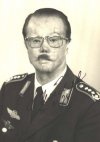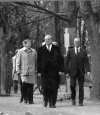Pierre Le Gloan: The ace on both sides
Le Gloan born in Kergrist-Moëlou (Fr) on June 1, 1913. He joined the French Armee de l’Air in 1931 as soon as he was old enough to enlist. With 18 kills to his name and France's fourth-highest-scoring ace of WW2, he remains the only pilot in history to become an ace on both sides of the same conflict.
When war came he was flying a Morane-Saulnier MS.406. On November 23, 1939 I have claimed his first kill of him, a Dornier DO.17 reconnaissance aircraft. Another DO.17 fell to his guns from him on March 2, 1940.
All pilots in Le Gloan’s squadron were then re-equipped with the newer and better Dewoitine D.520. During the Battle of France in the summer of 1940 he shot down four German and Italian bombers: two Heinkel 111 planes and two Fiat BR.20 bombers.
The highlight of Le Gloan’s career was to come on June 15. His squadron met a squadron of Italian CR.42 fighters. Attacking with enthusiasm, he shot down no less than three of them. Encountering another CR.42 and a BR.20 on his way back to base, Le Gloan attacked and shot down both of them. His five-kill streak brought him up to 11 kills, well above the five required for ace status. He was also promoted to 2nd Lt.
On June 20, his squadron was transferred to Algeria, then a French colony. With the fall of France and the installation of Marshal Petain’s Vichy government, the French forces in N. Africa were under Vichy command. To Le Gloan it made no difference. He’d flown, fought and killed for France. Now, he would do the same for Vichy.
His second fighting streak came in June and July of 1941. Fighting for Vichy and taking on RAF, Le Gloan shot down five of the Hurricane fighters, a Gloster Gladiator and another aircraft that remains unidentified. He’d taken down 11 for France and had added another seven for Vichy.
After the Vichy surrender all former Vichy forces were siding with the Allies including Le Gloan’s fighter squadron. Reequipped in May 1943 with the American P-39 Airacobra, that was his death sentence: an external fuel tank mounted under the belly meant to be jettisoned when empty or if about to enter a dogfight.
On Sept 11, 1943 your Airacobra began to experience mechanical problems. As the Airacobra was not the finest fighter ever built, this wasn’t unusual for pilots who had to fly them. With smoke streaming from his aircraft, Le Gloan decided to return to base and land, forgetting to jettison the drop tank. It was a fatal mistake.
As he touched the ground the undercarriage collapsed and the drop tank, still full, ruptured instantly. As the Airacobra screeched along the runway, the mixture of aviation fuel and sparks caused the plane to erupt into a fireball. Pierre Le Gloan, 18-kill ace, only pilot ever to become an ace on both sides in the same war, was burned alive.








































































































































![URL]]](http://[URL=%27https://i.imgur.com/nHhnJ9g.jpg%5b/img%27]https://i.imgur.com/nHhnJ9g.jpg[/img[/URL]])




